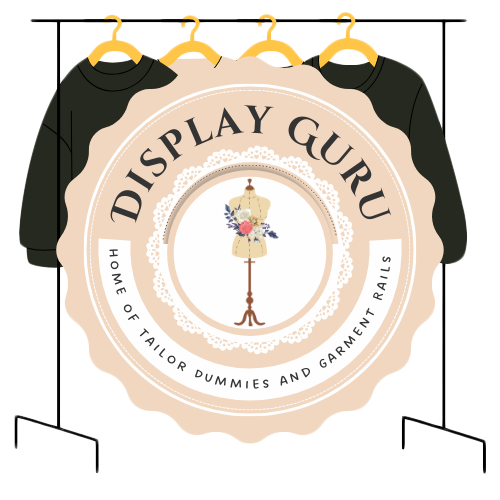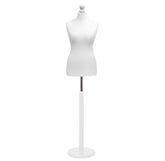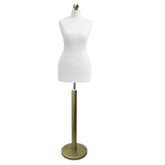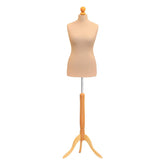Choosing Your Perfect Wig Head Mannequins
Think of a wig head mannequin as less of a simple holder and more of an indispensable partner in the life of your wig. It's the silent professional that supports every cut, colour, and style you create, ensuring your wig maintains its shape and lasts for years.
The Secret to Flawless Wig Styling
Whether you're a seasoned stylist in a bustling salon or just passionate about your personal collection, a wig head mannequin is the key to achieving professional-level results. It provides a stable, human-shaped canvas that turns routine wig care into a genuine craft.
Trying to style, wash, or cut a wig without one is a recipe for disaster. You could easily stretch the cap, create a tangled mess during washing, or end up with a wonky, uneven cut. This guide will show you how choosing the right mannequin can completely elevate your wig game. It's the difference between a wig tossed in a box and one that's perfectly preserved and ready to wear.
Why Every Wig Owner Should Have One
You don't need to be a pro to benefit from a mannequin head; it’s a smart, practical investment for anyone who owns a wig. These tools are crucial for a handful of tasks that keep your hairpiece looking its absolute best.
- Maintains Shape and Structure: A mannequin offers the support needed to stop the wig's cap from losing its form. This prevents stretching and guarantees a snug, comfortable fit every time.
- Makes Styling a Breeze: It gives you a stable, hands-free base to work from. You can cut, colour, and style with precision, seeing the wig from every angle just as it would look on a person.
- Helps with Washing and Drying: Washing a wig on a mannequin head is a game-changer. It helps prevent tangles and allows air to circulate evenly, which is vital for drying both synthetic and human hair wigs properly.
A great mannequin head is to a wig what a dress form is to a fashion designer. It provides the essential structure to build upon, allowing you to craft, refine, and perfect the final look until the hairpiece becomes a true work of art.
The demand for these tools is growing right alongside the hairpiece market itself. In 2019, the UK female wig and extension market was valued at around $612.9 million, a figure that's expected to nearly double by 2027. This explosion in popularity underscores just how essential wig head mannequins have become for both personal care and professional display.
For those in the business, these mannequins are more than just a convenience; they're a necessity. Understanding their role from day one is a key part of opening a successful beauty salon. Likewise, if you’re in retail, how you present your wigs can make or break a sale. Our visual merchandising guidelines offer some fantastic insights on making your products shine.
Selecting the Right Mannequin Head Material
Choosing the right material for your wig head isn't just a small detail—it's the most important decision you'll make. It fundamentally dictates how you can use it, what you can do with it, and how long it will last. Think of it like this: a jeweller wouldn't use a sledgehammer, and a serious wig stylist shouldn't use a flimsy display head for heavy-duty colouring.
Each material comes with its own unique set of strengths and weaknesses. The material choice impacts everything from durability and whether you can use pins, to its ability to handle heat styling. Getting this right is the first step to a smart investment that actually meets your needs, whether you're styling, storing, or simply displaying your wigs.
Canvas Block Heads: The Professional Standard
When you picture a professional wig maker’s workshop, the head you’re probably imagining is a canvas block head. For good reason, too. These are the gold standard for anyone serious about styling. They’re built with a sturdy cork or polyurethane base and wrapped in a tough canvas fabric, creating a firm surface that’s perfect for pinning.
Their biggest advantage is their compatibility with T-pins. This feature allows you to securely anchor a wig, giving you the stability needed for precise cutting, colouring, and heat styling without any annoying slipping or movement. The robust construction means they can easily handle the tension and pulling from creating intricate braids or elegant updos.
A canvas block head is to a wig stylist what a professional dress form is to a tailor. It’s a workhorse, built to last and designed for hands-on, detailed tasks. While they cost a bit more upfront, their longevity and superior function make them an essential piece of kit for professionals and dedicated wig enthusiasts alike.
For a professional, a high-quality canvas block head isn’t just a tool; it’s a non-negotiable part of their toolkit. Its ability to securely hold a wig provides the control and precision needed to execute flawless styles, making it the most reliable choice for any intensive wig work.
Styrofoam Heads: The Lightweight Option
Styrofoam (or polystyrene) heads are probably the most common and recognisable type you'll see. They're incredibly lightweight and very affordable, which makes them a go-to choice for beginners, temporary storage, or basic shop displays. Their main job is simply to help a wig keep its shape when it's not being worn.
But that low price point comes with some pretty significant trade-offs. Styrofoam isn't durable at all; it dents, chips, and breaks easily. More importantly, it’s completely unsuitable for any real styling work. Trying to stick pins into it will cause the material to crumble and disintegrate over time, and it will quickly lose any ability to hold a wig securely.
This decision tree can help you visualise which path to take based on your main goals.
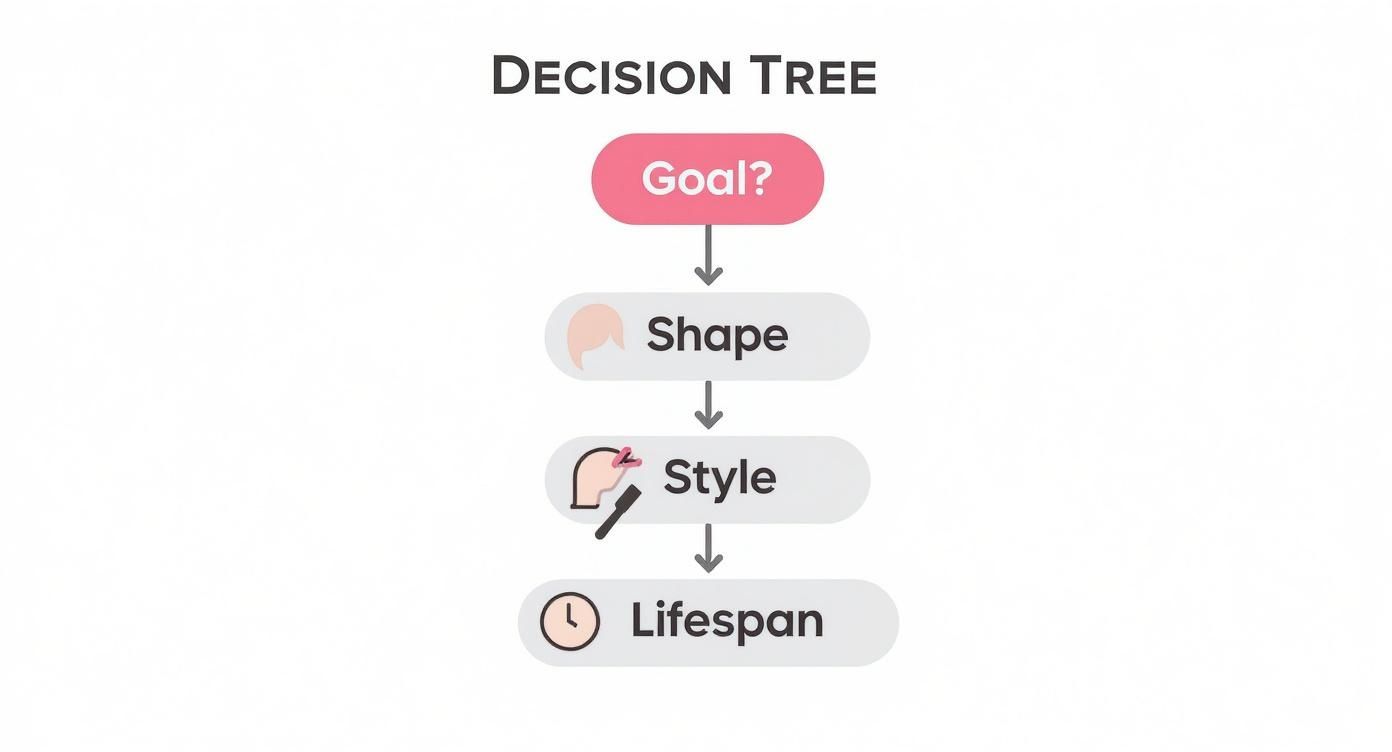
As the graphic shows, what you plan to do with the wig head is the most critical factor in choosing the right material.
Plastic and Glass Heads: The Display Specialists
Plastic and glass heads serve a completely different purpose. They are all about aesthetics, not function. With their sleek lines and often realistic facial features, these heads are designed to create elegant, eye-catching displays, whether in a retail environment or on a dressing table at home.
Plastic heads are a step up from styrofoam in durability and are still lightweight, but you can't pin into them and their slippery surface makes styling a real challenge. Glass heads are heavier and more stable, offering a premium, high-end look perfect for showcasing luxury wigs. Both are fantastic for visual merchandising; for retailers, knowing how to set up appealing mannequins for shops is a vital skill.
The crucial thing to remember is that neither of these materials is safe for heat styling. Applying heat from a curling iron or straightener can cause plastic to melt and glass to shatter. Their value is purely visual. They are perfect for photography, shop windows, or just keeping your wig looking pristine. Use them for showing off your pieces, but always switch to a canvas head for the actual work.
Comparing Wig Head Mannequin Materials
To make things even clearer, let's break down the pros and cons of each material in a simple table. This should help you quickly compare the options and pinpoint the best fit for your specific needs.
| Material Type | Best For | Durability | Pin Compatibility | Heat Styling Safe? |
|---|---|---|---|---|
| Canvas Block | Professional styling, making, colouring | High | Excellent (T-pins) | Yes |
| Styrofoam | Basic storage, temporary display | Low | Poor (crumbles) | No |
| Plastic | Retail display, photography | Medium | No | No |
| Glass | High-end retail, luxury display | Medium (fragile) | No | No |
Ultimately, your choice comes down to your primary use case. For hands-on work, nothing beats a canvas block head. For display, plastic or glass will give you that polished look. And for simple, budget-friendly storage, a styrofoam head will do the job.
Finding the Perfect Fit and Features
Think of it like this: you wouldn't store a bespoke suit on a hanger that's too wide or too narrow. The same principle applies to your wigs. If you put a wig on a mannequin head that’s too large, you'll inevitably stretch the cap, leading to a loose, sloppy fit. On the flip side, a head that’s too small won’t give you the tension you need for proper styling, cutting, or colouring.
Getting the size right isn’t just a nice-to-have; it's the foundation of good wig care.
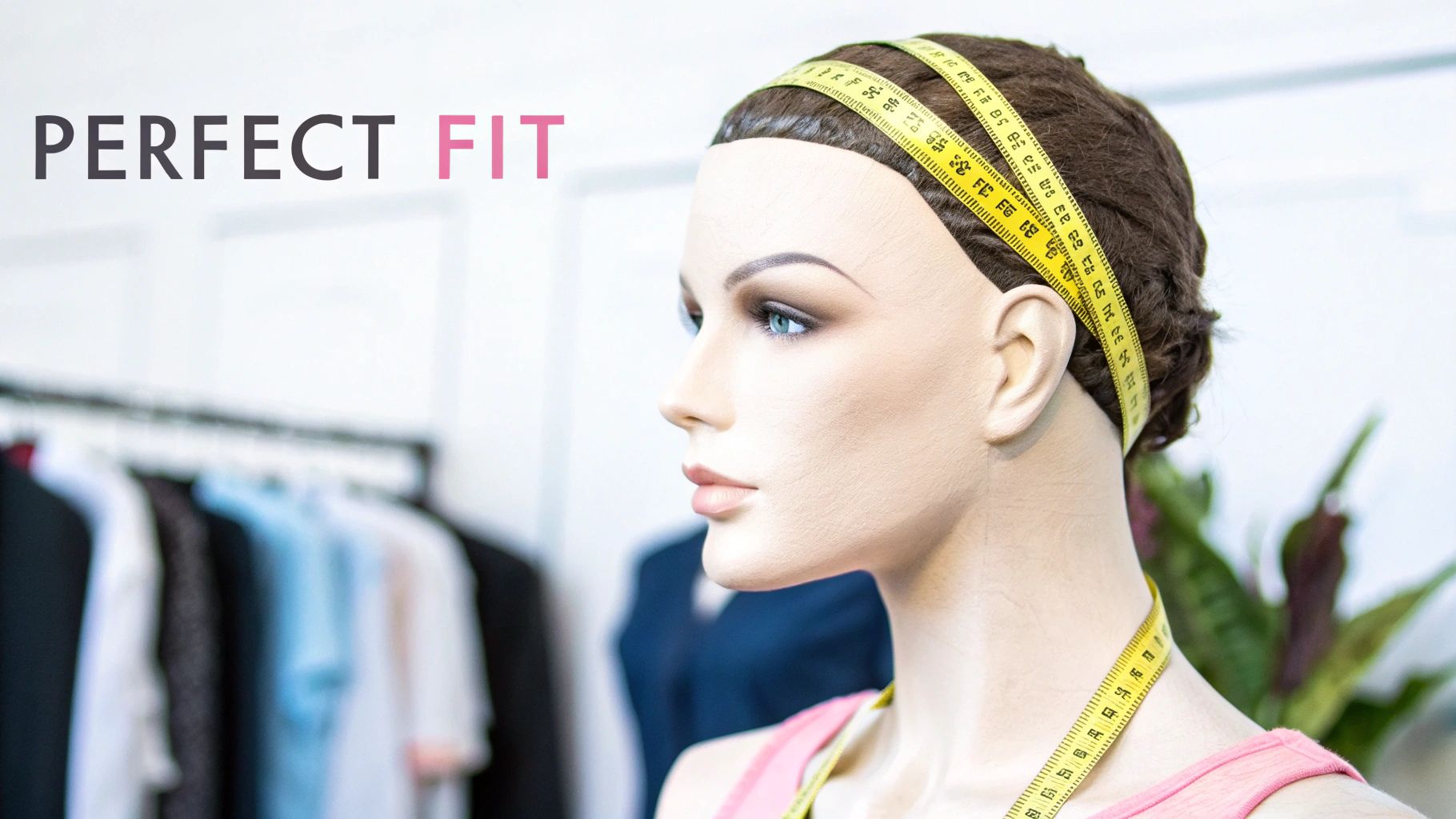
Choosing the wrong size is probably the most common—and costly—mistake I see people make. An overstretched wig cap is almost impossible to fix, permanently ruining how it sits and feels. Nail this first step, and you'll ensure every styling session goes smoothly and your wig stays in top-notch condition for years.
Nailing the Right Head Circumference
The most critical measurement you need is the head circumference. While the average adult female head is around 22.5 inches, professional canvas block heads come in a range of sizes, usually from 21 to 24 inches, to suit different people. The best way to find your match? Measure your own head.
Take a soft tape measure and wrap it around your head. Start at your forehead, run it just above your ears, and bring it around to the point where the back of your head starts to slope down. That number is your golden ticket. You'll want to buy a mannequin head that is either your exact size or about 0.5 inches smaller. Why smaller? Because you can always pad it out a bit for a snug fit, but you can’t un-stretch a wig that’s been forced onto a head that was too big.
For a more detailed breakdown, our guide on mannequin measurements has you covered.
Beyond Size: Essential Mannequin Features
While getting the size right is non-negotiable, a few other features can make a world of difference. These details can turn a simple stand into a proper styling tool, opening up a whole new world of creative possibilities.
Keep an eye out for these key features:
- Realistic Facial Features: If you're a makeup artist or practising theatrical looks, a head with defined eyes, a nose, and lips is a game-changer. It gives you a much better sense of how the wig and makeup will come together on a real person.
- Integrated Shoulders: A mannequin head with shoulders and a décolletage is brilliant for retail displays. It helps you show off how a wig looks with certain necklines or how it pairs with accessories like scarves and jewellery, creating a much more compelling visual for customers.
- Varying Neck Lengths: Don't underestimate the neck! A longer neck is perfect for showcasing long, elegant wig styles, giving them room to flow. For bobs and pixie cuts, a shorter neck helps keep the focus squarely on the hairstyle itself.
Choosing the right features is all about thinking ahead. A mannequin with shoulders isn't just a head; it's a styling partner that helps you tell a complete visual story, whether for a client, a customer, or your own creative projects.
By paying attention to these details, you're not just finding a place to park your wig. You're choosing a partner that will help you get professional, polished results every time. It’s this focus on the small things that elevates your setup from amateur to expert, making sure every wig you touch looks its absolute best.
Securing Your Workstation with Stands and Mounts
A great canvas block head is fantastic, but it's only half the story. Without a solid, stable base, even the most talented stylist will find it nearly impossible to get those perfectly precise results. Try painting a masterpiece on an easel that keeps shaking – it’s a recipe for frustration and messy work. That’s precisely why stands and mounts are so critical for your styling station.
These bits of kit provide the hands-free stability you need for everything from intricate braiding to a sharp, clean cut. Picking the right one really comes down to your workspace, the kind of jobs you're doing, and how much heavy use it needs to stand up to. Ultimately, this stability is the core reason wig head mannequins are such an essential tool in the first place.
This is especially true for professionals. In fact, the mannequin head market segment for wig and hairpiece design pulled in a huge 28.4% of the total market revenue. In the UK, this reflects just how much wigs are being used and how much stylists rely on these tools for designing and shaping pieces with absolute precision. You can check out more details on mannequin head market trends on DecisionsAdvisors.com.
Tabletop Clamps for Compact Spaces
If you’re working in a tight spot, a tabletop clamp is a brilliant bit of gear. These simple C-clamps fasten right onto the edge of a desk or counter, giving you a surprisingly firm grip without taking up any precious floor space. They’re lightweight, portable, and dead simple to set up, which makes them perfect for home users or mobile stylists.
A tabletop clamp is your go-to for lighter tasks like basic styling, gently detangling, or letting a wig air-dry after a wash. For the heavy-duty stuff, though—like a vigorous colouring session or cutting very thick hair—they might not give you the resistance you need. Think of it as a reliable helping hand for your everyday styling.
Tripod Stands for Ultimate Stability
When you need that rock-solid, no-compromise stability, nothing beats a proper tripod stand. This is the professional standard you'll see in salons and workshops everywhere, and for good reason. A tripod gives you a freestanding, robust base that can handle even the most intensive styling techniques. Plus, its adjustable height means you can work comfortably whether you're sitting or standing, which saves your back and shoulders a lot of grief.
This level of security is absolutely crucial for jobs that demand both strength and precision:
- Heavy-Duty Cutting: A tripod holds the head perfectly still, so you can achieve those even, accurate cuts.
- Intense Colouring: It stops any movement while you apply colour, ensuring you get perfect, even saturation.
- Heat Styling: The solid base gives you the stability needed to apply tension with your brushes and hot tools safely.
A good tripod is a real investment in your work's consistency and professionalism. For a closer look at the different types, you might find our guide on choosing a head mannequin stand helpful.
Suction Cup Mounts for Smooth Surfaces
A less common but incredibly handy option is the suction cup mount. These gadgets have a powerful suction base that sticks firmly to smooth, non-porous surfaces like glass, polished stone, or laminate worktops. They create a strong vacuum seal, offering fantastic stability for quick jobs.
The biggest plus is that they're portable and don't leave a mark, so you can move them around in seconds. This makes them great for travel or for stylists who work on-site. The catch, however, is that their reliability is completely dependent on the surface – they just won't work on wood, textured tables, or anything with even the slightest bit of porosity.
Choosing the right mount is all about matching the tool to the task. A hobbyist might love the convenience of a clamp, but a professional stylist creating a custom wig needs the unshakeable foundation that only a tripod can provide.
At the end of the day, the right stand is what turns your wig head mannequin from a simple holder into a proper, functional workstation. By getting rid of the wobbles and slips, you create a secure setup where you can focus completely on your craft, making sure every style you create is executed flawlessly.
Putting Your Mannequin to Work
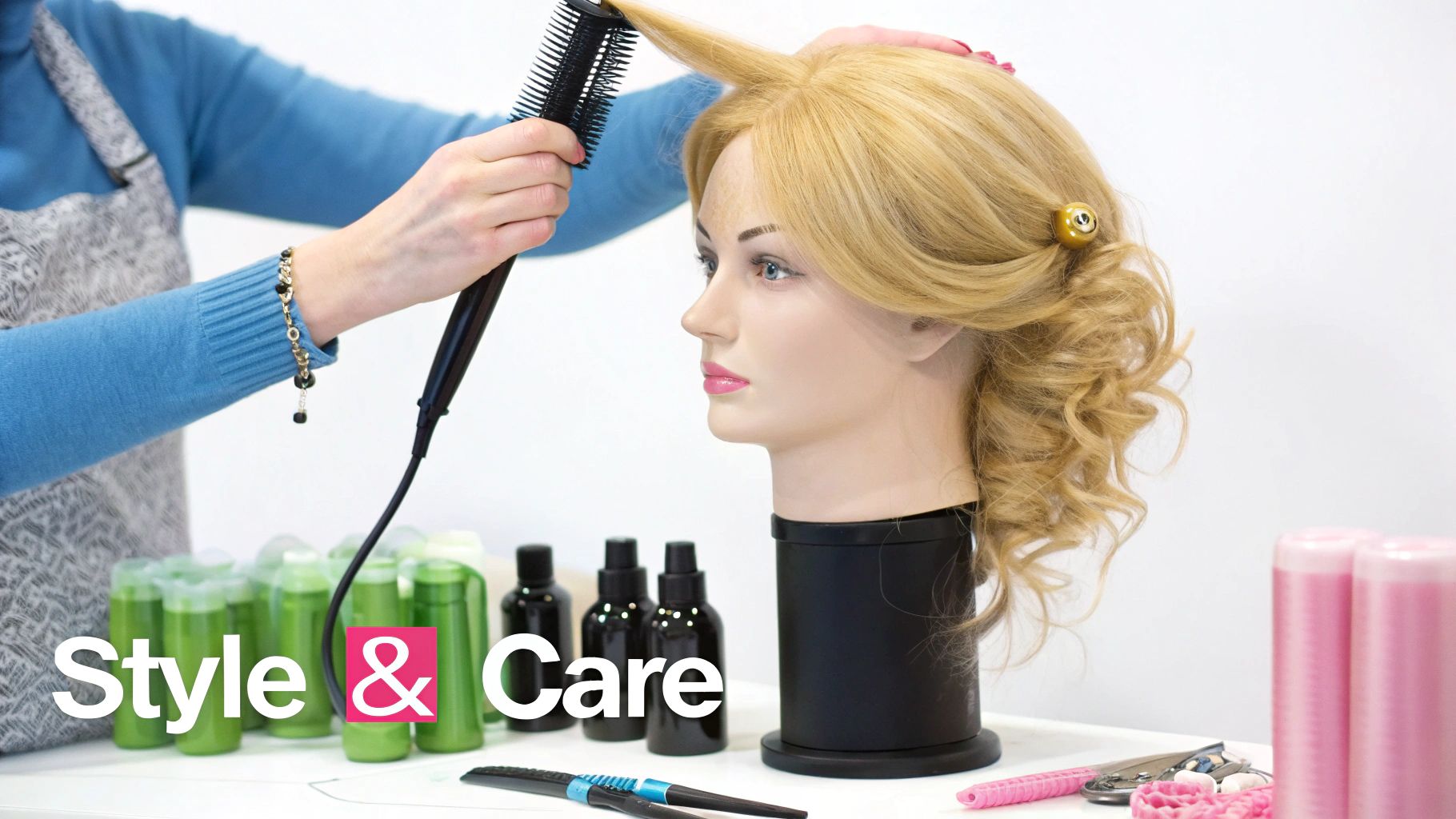
So, you’ve picked out the perfect wig head. Now it’s time to put it to good use and really see what it can do. A mannequin head is so much more than just a place to hang your wig; it’s a proper workstation that makes looking after your pieces easier and more professional.
Think of it as your silent styling assistant. When your wig is secured properly, you’ve got both hands free to work, giving you far more control and a 360-degree view of what you’re doing. Let's walk through how you can use your mannequin to wash, style, and display your wigs like a true expert.
Mastering Wig Washing and Conditioning
Trying to wash a wig by holding it under a tap is a nightmare. You’re practically guaranteed to end up with a tangled mess and an uneven clean. Using a mannequin head changes everything. It holds the wig just as a human head would, so water and products can run through the fibres naturally from root to tip.
This method not only stops tangles before they start but also gives you a much deeper, more thorough clean. Just pop your wig onto a waterproof mannequin head (if it’s canvas, cover it with a plastic cap first), place it in a sink, and gently work the shampoo and conditioner through. Rinsing is a breeze, and you can be sure every last bit of product is gone.
A mannequin head transforms the awkward task of wig washing into a controlled, gentle process. It allows you to treat the wig with the same care and technique you would use on natural hair, significantly extending its life and preserving its texture.
The mannequin’s job isn’t over after the final rinse, either. Leaving the wig on its stand to air-dry is the best way to maintain the cap's shape and ensure air circulates all the way through, which is vital for preventing any mildew and making sure it dries completely.
Precision Styling and Cutting
This is where your mannequin head really earns its keep. For both professionals and home users, a stable base is essential for getting a sharp cut or a polished style. Securing the wig with T-pins onto a sturdy canvas head means it won’t slip or slide, letting you work with complete confidence.
Just think of the tasks made simpler with a mannequin:
- Cutting and Trimming: You can finally achieve perfectly even lines, balanced layers, and a straight fringe. The steady base lets you step back and check the shape from every angle.
- Heat Styling: Safely use your curling wand or straighteners on heat-friendly wigs without juggling a hot tool in one hand and a wig in the other.
- Intricate Updos: Creating complex braids, twists, and elegant updos becomes so much easier when you have both hands free to section, pin, and perfect your look.
Of course, great tools need great products to match. If you’re building your styling kit, you can Find the Best Hair Styling Products for Your Hair to get professional results.
Elevating Your Retail Displays
Mannequin heads aren't just for behind-the-scenes work; they are absolute essentials for visual merchandising. A wig in a box is just an item. But a wig displayed on a mannequin head? That’s an aspirational look a customer can immediately imagine themselves wearing.
This kind of visual storytelling is a seriously powerful sales tool. In fact, the global mannequin head market was valued at over USD 1 billion, with the UK's wig design sector making up almost 29% of that. Much of this growth is down to e-commerce and social media, where a great photo is everything.
For retailers, displaying wigs on mannequins that have realistic features—or even shoulders to show off a complementary necklace—helps create a full, compelling look. To take your presentation skills to the next level, have a look at our guide on https://www.displayguru.co.uk/blogs/news/how-to-dress-a-mannequin for maximum impact. From the workshop to the shop floor, a mannequin adds value at every step.
Common Questions About Wig Head Mannequins
Even after you've got the basics down, a few specific questions tend to pop up once you start working with a wig head. This section is your go-to reference, packed with clear, straightforward answers to the queries we hear most often. We’ll get into the practical details to clear up any lingering doubts and help you use your mannequin like a pro.
Getting these little things right is about more than just protecting your investment; it's about getting the absolute best results from all your hard work styling. Let's jump into the key questions that can make a real difference.
Can I Use a Styrofoam Head for Heat Styling?
This one comes up a lot, and the answer is a firm and simple: absolutely not. Trying to use heat stylers like curling wands or straighteners on a wig that’s sitting on a styrofoam head is asking for trouble. Styrofoam just can't take the heat; it has an incredibly low melting point and will start to warp or melt almost instantly.
This creates two huge problems. First, the melting styrofoam can actually fuse the wig cap to the head, completely ruining both your wig and your mannequin. Second, the melting process can release some nasty, and potentially harmful, fumes.
Remember, styrofoam heads are really only meant for basic storage or displaying a wig without any styling. They simply aren't designed for the demands of active styling, especially when heat is involved.
If you plan on using any heat, your only safe bet is a canvas block head. These are specifically built with a sturdy cork or polyurethane core that can handle moderate temperatures without melting or losing its shape. Just be sure the wig itself is made from human hair or heat-friendly synthetic fibres before you start!
How Do I Choose the Correct Size Mannequin Head?
Picking the right size is probably the single most important decision you'll make. A mannequin head that's too big will stretch out the wig's cap, leaving you with a loose, awkward fit that’s pretty much impossible to reverse. On the other hand, a head that’s too small won’t give you the tension you need to style the wig properly.
Finding your perfect match is easy. Just follow these steps:
- Measure Your Own Head: Grab a soft tailor's tape measure. Start it at the centre of your forehead, run it just above your ears, and circle it around the fullest part of the back of your head. That number is your head circumference.
- Select the Right Size: Professional-grade canvas wig head mannequins usually come in sizes from 21 to 24 inches. You’ll want to choose a mannequin that either matches your measurement exactly or is about half an inch smaller.
- Adjust for a Custom Fit: It's always better to go slightly smaller than too large. If the fit isn't quite snug enough, you can easily add a bit of padding with some fabric or foam strips to create that perfect, customised grip for your wig.
A well-fitting mannequin ensures your wig keeps its intended shape and structure, preserving its fit for years to come.
What Is the Best Way to Clean My Mannequin Head?
Keeping your mannequin head clean is crucial for both hygiene and its lifespan, but the cleaning method really depends on the material it's made from.
- Plastic and Glass Heads: These are the easiest to look after. A simple wipe-down with a soft, damp cloth and a touch of mild soap is all you need. Just steer clear of any abrasive cleaners that might scratch the surface.
- Styrofoam Heads: You need to be very gentle here. Use a lightly dampened cloth to dust it off or remove any product residue. Avoid harsh chemicals or solvents at all costs, as they can dissolve the styrofoam.
- Canvas Block Heads: These require the most care. It's best to spot-clean any stains using a gentle fabric cleaner or a mix of mild detergent and water.
One of the most important things to remember with a canvas head is drying. If you wash a wig while it's on the head, the canvas will absorb a lot of that moisture. It’s vital to let it air dry completely in a well-ventilated space to stop mildew or mould from growing inside.
Here’s a great pro tip: before you put a wet wig on your canvas head, cover the head with a plastic cap or some cling film. This simple trick protects the canvas from water and styling products, helping it last so much longer.
At Display Guru, we provide a wide range of high-quality wig head mannequins and stands to suit every need, from professional styling to elegant retail displays. Find the perfect foundation for your wigs and elevate your craft today.
